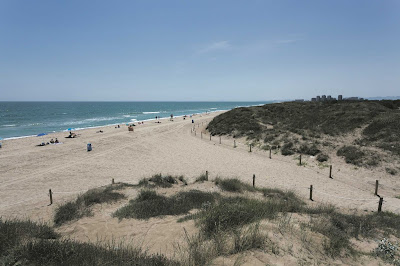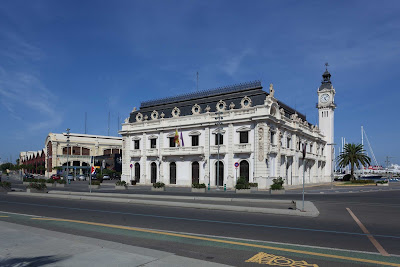Cabanyal, Malvarrosa, Patacona & La Devesa
Have you chosen Valencia because this year you wanted to do city tourism, without giving up your break facing the sea? Well, you’re in luck! Valencia’s beaches will surprise you!
The Cabanyal beach (Las Arenas)
This urban beach is located right next to “La Marina de València”, just five kilometres from the Town Hall Square and is very well communicated. There was formerly a private beach within it, but now it is public for the enjoyment of the Valencians and tourists.
It has a length of about 1,200 metres and an average width of 135 metres. So, despite being the most frequented, you will have no problem spreading your towel on its fine golden sand. In addition, if you prefer to lay under a beach umbrella or hammock, it also has this service. And for food or drink, do not worry! Known by the Valencians as the “Las Arenas” beach, it has a fantastic and traditional restaurant area with terraces that overlook the port and the northern part of the “Costa del Azahar”.
The Malvarrosa beach
A source of inspiration for numerous artists like the painter Joaquin Sorolla or the writer Vicente Blasco Ibáñez, the “Malvarrosa” beach is another urban beach treat for the visitor. In a way, it is still the extension to the north of “Las Arenas” beach, with the new neighbourhood’s special characteristics and range of the most widespread restoration.
If you like to do sports: play volleyball, soccer, shovels, or enjoy watching your kids climbing up fun ropes, come in at dusk and feel the sand’s coolness on your feet. Even during the day, the width of the beach will also allow you to practice your hobbies without disturbing or being disturbed by anyone.
And what to say about running on the shore, walking or biking along the promenade by the breeze! You have to experience it!
La Patacona beach
If you continue along the Malvarrosa beach to where the sand takes you, without hardly realising it you will have reached Alboraya, the Valencia’s bordering town that houses “La Patacona”. A beach of something more than a kilometre, also open and wide, in which it will not be difficult to contemplate mounted horseback strollers first thing in the morning.
The delight of this beach are the old houses facing the sea converted into restaurants that have been decorated with an exceptional taste. To move about there to eat, dine or have coffee, in one of the premises with outdoor and indoor terraces, will be a great discovery.
El Saler and La Garrofera beaches
To the south of Valencia, but within its municipal limits, is the “Devesa de La Albufera”. It is an unrivalled spot for dunes, fauna and vegetation of 10 kilometres in length and approximately one kilometre wide. There are six waymarked itineraries in it, differentiated by themes and colours, which together represent more than eight kilometres to journey.
Most impressive: its location between the Mediterranean to the East and the rice paddies and lagoon of “La Albufera” to the West. To combine a walk on this arm of paradisiacal land with a good dip in the beaches of “El Saler” or “La Garrofera” and a sunset in front of “La Albufera” will, as a result, be very energetic and romantic.
Valencia is the perfect destination to live all that a millenary and changing city has to offer you, without giving up a beach vacation
Have you chosen Valencia because this year you wanted to do city tourism, without giving up your break facing the sea? Well, you’re in luck! Valencia’s beaches will surprise you!
The Cabanyal beach (Las Arenas)
This urban beach is located right next to “La Marina de València”, just five kilometres from the Town Hall Square and is very well communicated. There was formerly a private beach within it, but now it is public for the enjoyment of the Valencians and tourists.
It has a length of about 1,200 metres and an average width of 135 metres. So, despite being the most frequented, you will have no problem spreading your towel on its fine golden sand. In addition, if you prefer to lay under a beach umbrella or hammock, it also has this service. And for food or drink, do not worry! Known by the Valencians as the “Las Arenas” beach, it has a fantastic and traditional restaurant area with terraces that overlook the port and the northern part of the “Costa del Azahar”.
The Malvarrosa beach
A source of inspiration for numerous artists like the painter Joaquin Sorolla or the writer Vicente Blasco Ibáñez, the “Malvarrosa” beach is another urban beach treat for the visitor. In a way, it is still the extension to the north of “Las Arenas” beach, with the new neighbourhood’s special characteristics and range of the most widespread restoration.
If you like to do sports: play volleyball, soccer, shovels, or enjoy watching your kids climbing up fun ropes, come in at dusk and feel the sand’s coolness on your feet. Even during the day, the width of the beach will also allow you to practice your hobbies without disturbing or being disturbed by anyone.
And what to say about running on the shore, walking or biking along the promenade by the breeze! You have to experience it!
La Patacona beach
If you continue along the Malvarrosa beach to where the sand takes you, without hardly realising it you will have reached Alboraya, the Valencia’s bordering town that houses “La Patacona”. A beach of something more than a kilometre, also open and wide, in which it will not be difficult to contemplate mounted horseback strollers first thing in the morning.
The delight of this beach are the old houses facing the sea converted into restaurants that have been decorated with an exceptional taste. To move about there to eat, dine or have coffee, in one of the premises with outdoor and indoor terraces, will be a great discovery.
El Saler and La Garrofera beaches
To the south of Valencia, but within its municipal limits, is the “Devesa de La Albufera”. It is an unrivalled spot for dunes, fauna and vegetation of 10 kilometres in length and approximately one kilometre wide. There are six waymarked itineraries in it, differentiated by themes and colours, which together represent more than eight kilometres to journey.
Most impressive: its location between the Mediterranean to the East and the rice paddies and lagoon of “La Albufera” to the West. To combine a walk on this arm of paradisiacal land with a good dip in the beaches of “El Saler” or “La Garrofera” and a sunset in front of “La Albufera” will, as a result, be very energetic and romantic.

